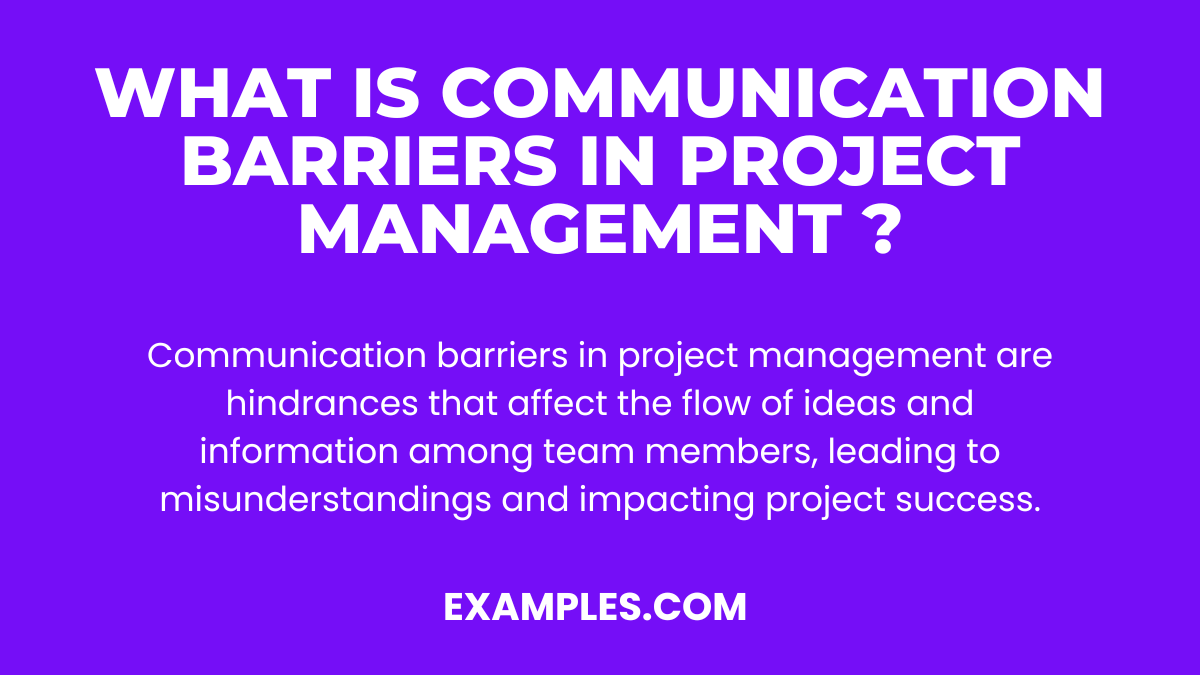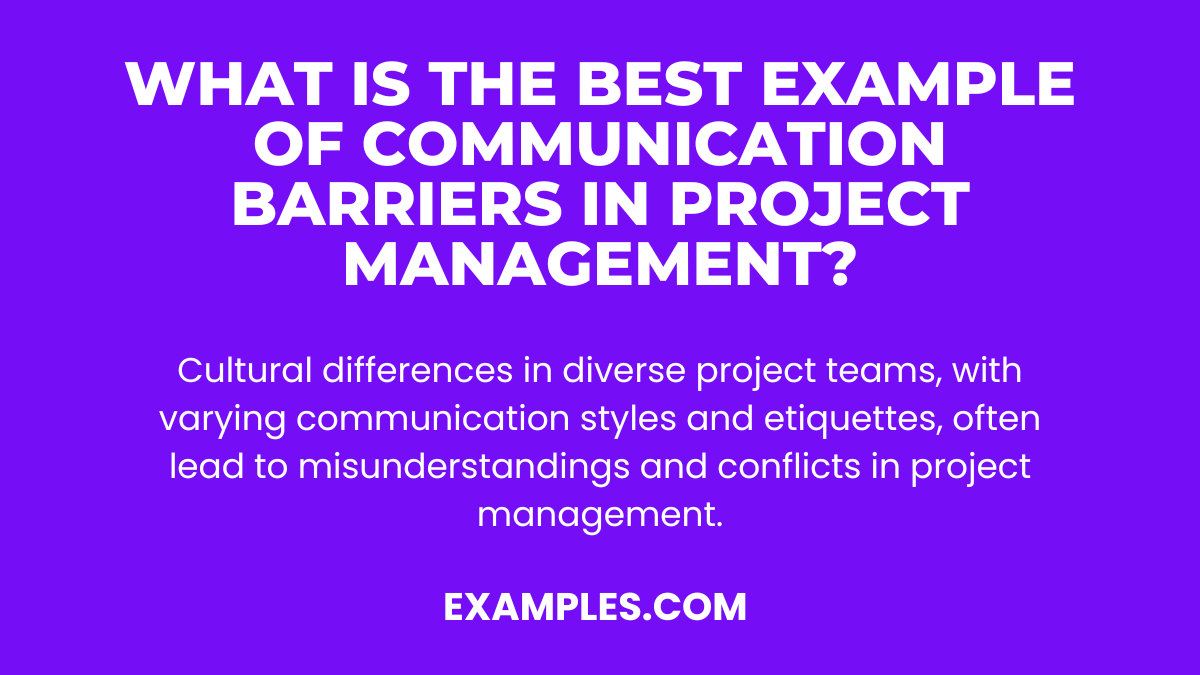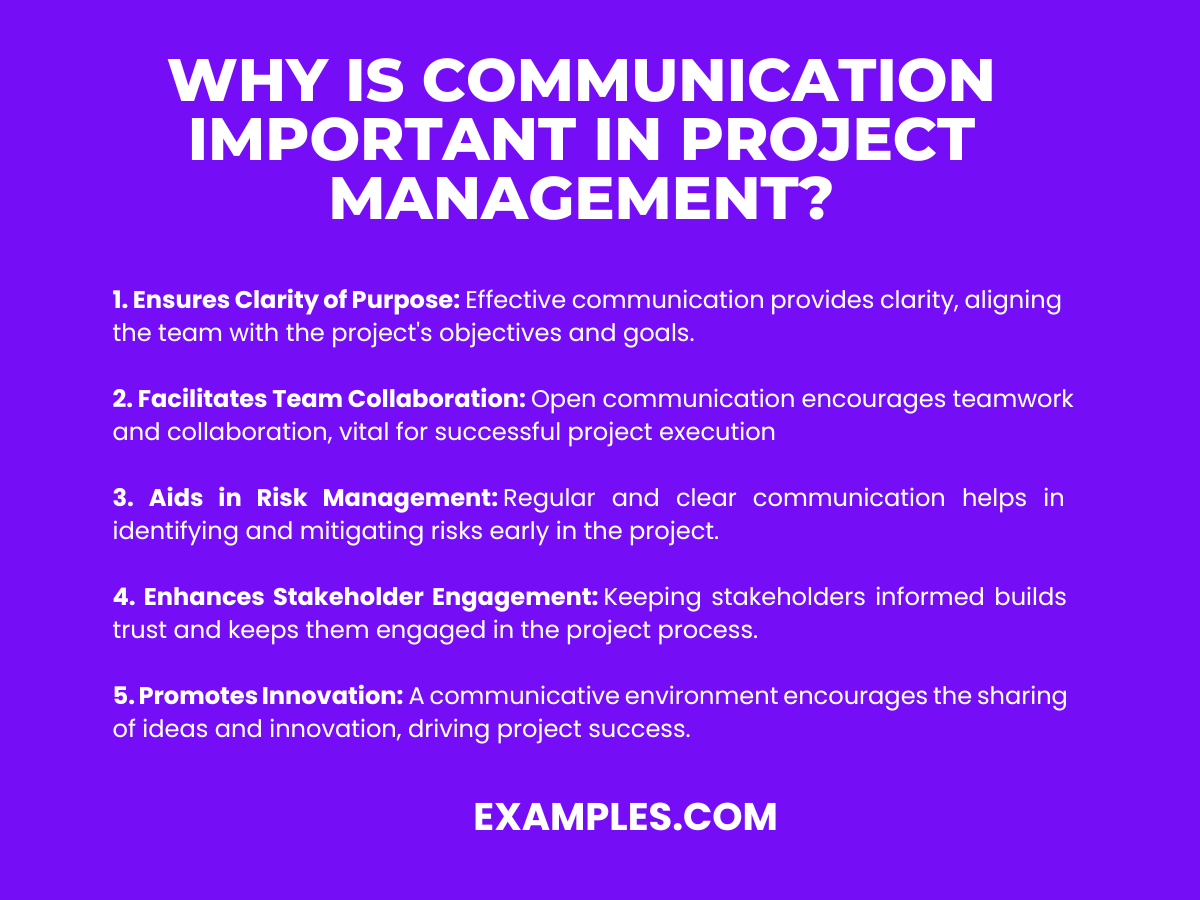30+ Communication Barriers in Project Management Examples
In the dynamic realm of project management, communication barriers often hinder team progress and success. This comprehensive guide delves into various communication examples within project teams, highlighting common obstacles and providing practical solutions. From cultural misunderstandings to language challenges, we explore how these barriers manifest and affect project outcomes. With real-world examples and expert insights, this guide is an essential resource for managers and team members aiming to enhance communication and drive project success.
What is Communication Barriers in Project Management ?
Communication barriers in project management refer to obstacles that hinder effective exchange of ideas, information, and understanding among team members. These barriers can occur due to various factors such as cultural differences, language issues, and ineffective communication techniques. They often lead to misunderstandings, delays, and conflicts within a project, impacting its overall success. Understanding and addressing these barriers is crucial for smooth and efficient project management.
What is the Best Example of Communication Barriers in Project Management?
A quintessential example of communication barriers in project management is the presence of cultural differences within a diverse team. When team members come from different cultural backgrounds, they bring varied communication styles, business etiquettes, and perceptions. For instance, in some cultures, direct communication is valued, whereas, in others, indirect and subtle ways of conveying messages are preferred. This can lead to misunderstandings, where one team member might perceive a colleague’s indirect communication as evasive or unclear, while the colleague might find direct communication confrontational.
Communication barriers in project management Examples
In project management, communication barriers can derail even the most meticulously planned projects. These obstacles range from interpersonal conflicts to technological hiccups, each presenting unique challenges. Understanding these barriers, their causes, and how to address them is crucial for the smooth functioning of any project.
- Interpersonal Conflict in Projects: Caused by personality clashes or differing work styles. Fix it by fostering a culture of open dialogue and conflict resolution strategies.
- Cultural Differences in Project Teams: Misunderstandings arise from diverse cultural backgrounds. Overcome by promoting cultural awareness and sensitivity training.
- Language Barriers in Team Management: Non-native speakers may struggle with nuances. Implement clear language protocols and use visual aids for clarity.
- Ineffective Team Collaboration Techniques: Inefficient collaboration tools or methods can hinder communication. Adopt proven collaboration tools and regularly review their effectiveness.
- Challenges of Virtual Team Communication: Physical distance can lead to a lack of engagement. Utilize video conferencing and regular check-ins to bridge the gap.
- Misinterpretation in Project Discussions: Ambiguous instructions or feedback can create confusion. Ensure clarity by using unambiguous language and confirm understanding.
- Lack of Project Feedback Mechanisms: Without proper feedback channels, issues can go unresolved. Establish regular feedback sessions and an open-door policy for concerns.
- Project Management Communication Tools: Inadequate tools can impede information flow. Choose tools that best fit the team’s needs and ensure proper training.
- Organizational Structure Impacts on Team Communication: Hierarchical structures can intimidate lower-level employees from speaking up. Encourage an open culture where all voices are valued.
- Effective Leadership and Team Dialogue: Poor leadership can lead to miscommunication. Leaders should practice active listening and encourage team discussions.
Communication Barriers in Project Management for Students
In academic settings, students often encounter unique communication barriers in project management. These challenges can stem from a lack of experience, diverse educational backgrounds, and varying levels of commitment. Understanding and overcoming these barriers is key to successful project execution and team collaboration in a learning environment.
- Inexperienced Project Leadership: Students may lack experience in leading teams.
How to Communicate: “Let’s brainstorm together and find the best approach for our project.” - Varied Academic Strengths: Different strengths can lead to unbalanced work distribution.
How to Communicate: “Can we align our tasks based on everyone’s strengths?” - Time Management Issues: Balancing coursework with project deadlines.
How to Communicate: “Let’s create a realistic timeline that works for everyone.” - Technology Familiarity Gaps: Not all students are equally tech-savvy.
How to Communicate: “Let’s offer a quick tutorial on this software for those unfamiliar with it.” - Fear of Speaking Up: Some students might hesitate to share ideas.
How to Communicate: “Every idea is valuable, feel free to share your thoughts.” - Peer Pressure: Influences can affect decision-making.
How to Communicate: “Let’s make decisions based on the project’s needs, not peer pressure.” - Over-Reliance on Digital Communication: Losing personal touch in remote settings.
How to Communicate: “Let’s have a face-to-face meeting this week to connect better.” - Language and Cultural Differences: Diversity can lead to misinterpretations.
How to Communicate: “Could you please clarify that point for better understanding?” - Lack of Professionalism: Informal communication leading to misunderstandings.
How to Communicate: “Let’s maintain a professional tone in our project discussions.” - Inadequate Feedback: Not receiving constructive criticism for improvement.
How to Communicate: “I would appreciate any feedback on my part of the project.”
Communication Barriers in Project Management for Staff
In the professional world, staff in project management face distinct communication challenges. These barriers can range from hierarchical differences to conflicting departmental goals, significantly impacting project outcomes.
- Hierarchical Communication Blocks: Authority gradients can hinder open dialogue.
How to Communicate: “I value your input, regardless of our positions.” - Interdepartmental Conflicts: Varying department goals can create barriers.
How to Communicate: “Let’s find a common ground that benefits both departments.” - Resistance to Change: Staff reluctance towards new methods or tools.
How to Communicate: “Let’s discuss the benefits of this new approach for our team.” - Workplace Politics: Navigating political dynamics can be challenging.
How to Communicate: “Our focus should remain on the project’s success, not politics.” - Technological Hurdles: Adapting to new project management software.
How to Communicate: “Training sessions are available to ease into this new tool.” - Work-Life Balance Struggles: Overworking leading to communication breakdowns.
How to Communicate: “Your well-being is important; let’s balance workload effectively.” - Lack of Clear Objectives: Unclear project goals leading to confusion.
How to Communicate: “Let’s clarify our objectives to ensure everyone’s on the same page.” - Email Overload: Excessive emails leading to missed information.
How to Communicate: “Let’s summarize key points in our emails for clarity.” - Inconsistent Meeting Agendas: Unproductive meetings due to poor planning.
How to Communicate: “A clear agenda will help make our meetings more effective.” - Lack of Recognition: Demotivation due to unrecognized efforts.
How to Communicate: “Your contributions to this project are highly valued and important.”
What are the Barriers to Communication in Project Management?
- Cultural and Language Differences: Diverse teams often face challenges in understanding each other’s cultural norms and language nuances.
- Technological Challenges: Over-reliance on communication barriers in the workplace can lead to overuse or misuse of technology, leading to miscommunications.
- Hierarchical Structures: Top-down communication in an organization can create barriers in conveying messages effectively across different levels.
- Physical Barriers: Remote work environments and different time zones can impede timely and clear communication.
- Psychological Barriers: Personal biases and preconceived notions, similar to personal communication barriers, can lead to misinterpretations or conflict.
- Lack of Clarity and Conciseness: Vague instructions or overly complex language can lead to misunderstandings in project objectives.
- Noise and Distractions: External and internal noise can disrupt the flow of communication, crucial in fast-paced project settings.
How Does Lack of Communication Affect Project Management?
- Delays in Project Delivery: Ineffective communication can cause misunderstandings, leading to delays in project timelines.
- Reduced Team Morale: Poor communication can lead to frustration and disengagement among team members.
- Increased Risk of Errors: Miscommunications can result in errors, affecting the quality of the project outcome.
- Budget Overruns: Misunderstandings in requirements or scope can lead to unexpected expenses, affecting the project budget.
- Stakeholder Dissatisfaction: Lack of clear communication with stakeholders can lead to dissatisfaction and trust issues.
Why is Communication Important in Project Management?
- Ensures Clarity of Purpose: Effective communication provides clarity, aligning the team with the project’s objectives and goals.
- Facilitates Team Collaboration: Open communication encourages teamwork and collaboration, vital for successful project execution.
- Aids in Risk Management: Regular and clear communication helps in identifying and mitigating risks early in the project.
- Enhances Stakeholder Engagement: Keeping stakeholders informed builds trust and keeps them engaged in the project process.
- Promotes Innovation: A communicative environment encourages the sharing of ideas and innovation, driving project success.
What is Communication Risk in Project Management?
Communication risk in project management involves the potential for misunderstandings, misinterpretations, or information gaps that can negatively impact project outcomes.
How Do You Ensure Communication in Project Management?
To ensure communication in project management, establish clear communication plans, utilize effective tools, encourage open dialogue, and maintain regular updates and feedback mechanisms
In conclusion, effectively managing communication barriers in project management is crucial for project success. Understanding these barriers and implementing strategies to overcome them enhances team collaboration and project outcomes. For further insights on this topic, exploring resources like Northeastern University’s guide on Communication in Project Management and the PMI’s article on Overcoming Cultural Barriers in Implementing Change can be invaluable. These resources offer deep dives into practical solutions and strategies to navigate communication challenges in diverse project environments.





